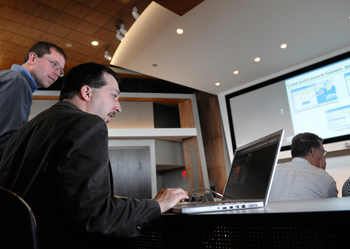 Video games are evolving as fast as the technology that builds them can develop, and those technologies are being applied to uses beyond monitors and joysticks. Many of those applications were on display last week at the Learning and Entertainment Evolution Forum at Harrisburg University of Science and Technology.
Video games are evolving as fast as the technology that builds them can develop, and those technologies are being applied to uses beyond monitors and joysticks. Many of those applications were on display last week at the Learning and Entertainment Evolution Forum at Harrisburg University of Science and Technology.
Close to 80 people attended the two-day forum, intended for those already working in the field or those just starting out.
“We’ve done significant events here for high school kids, but this was our first significant business-based national event,” says Andy Petroski, co-coordinator of the event and the school’s Master of Science program. “We had attendees from California and Texas, presenters from Toronto.”
The keynote session explored neuroscience and game/simulation design and development as separate disciplines that have advanced considerably in recent years. The discussion focused on current brain research and learning, how emotion and rewards impact retention and skills, and how unexpected outcomes are processed in the brain.
Exhibitors included: a crowd gaming system by CrowdPlay that enables a group of people to use movement to control on-screen gameplay, with players becoming the “joysticks;” the world’s first 3D monitor; a software device called Wild Pockets that lets users build games and create interactive 3D advertising experiences; and a University of Maryland group’s first responder simulation in a virtual world using headsets and two-way radio communication.
“It was a fun event, having a chance to go out and find these case studies from a number of different venues, see what people are doing and get really excited,” says Petroski.
Source: Andy Petroski, Harrisburg University of Science and Technology
Writer: Joe Petrucci